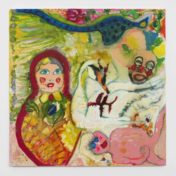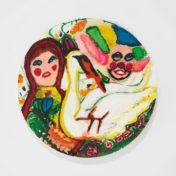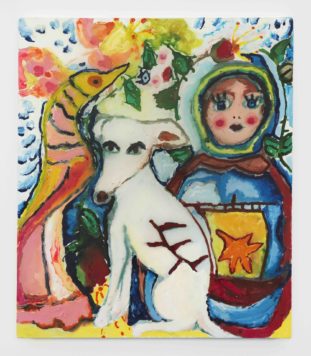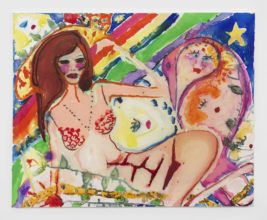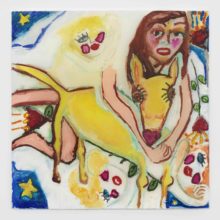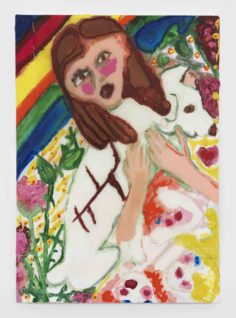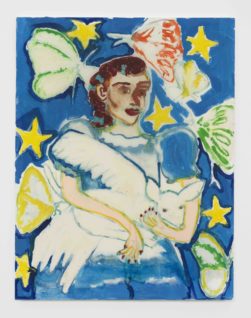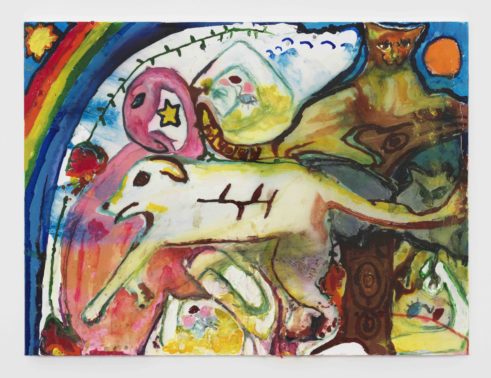Images Courtesy of Ruttkowski;68 and the artist
Dear Shaded Viewers,
Paz de la Huerta, the New York-born actress and artist, returns with her second solo exhibition, “Sacrifice,” co-presented by Ruttkowski;68 and Reference Studios in Berlin. This show could be considered as a public ritual, a reckoning, and a rebirth.
I first saw the art of Paz de la Huerta when she held a party in Paris for our mutual friend, Steve Olson. Her art is an act of self-adoption, a reclamation of identity in the absence of familial warmth. Her canvases are not just surfaces but wombs-places where she rebirths herself, filling the void left by a childhood marked by isolation and pain. In her own words and brushstrokes, Paz becomes both mother and daughter, Madonna and martyr, forging a lineage that begins and ends with herself. Each painting is a confession, a scar, and a testament to survival.
Her work is essential, instinctive, and trance-like-a visual language that recalls the imprints of childhood dreams and nightmares. There is a barbaric immediacy to her style, a brutal honesty that refuses to be prettified or contained. The figures she paints are often caught in moments of helpless nudity, their beauty shown carelessly, as if to defy the world’s gaze and reclaim agency over her own image. Paz’s canvases pulse with dense color and crowded forms, where angels, animals, and women intermingle in a maximalist fever dream. These are not mere memories, but “memories of memories”-tableaux that shift and warp, as if seen through the watery lens of trauma and recovery.
There is a mystical, almost religious undercurrent to her work. Paz paints herself in a pre-fetal state, suspended between suffering and rebirth, as if awaiting her own emergence into the world. Each image feels dictated by an “ideal inner infant,” a voice from deep within that whispers of innocence lost and reclaimed. Her paintings echo the iconography of saints and martyrs, yet they are resolutely secular in their insistence on personal truth. In this sense, Paz’s art becomes her gospel-a chronicle of pain transmuted into beauty, of isolation transformed into spiritual strength.
Paz de la Huerta’s personal history is not hidden behind her art; it is its very substance. She has spoken openly about surviving profound abuse and isolation, and her journey through these “valleys of tears” is not just cathartic but generative. “Isolation is the gift,” she quotes Bukowski, and within that solitude, she has found a wellspring of creativity and faith. Her engagement with spirituality, from Catholicism to South American plant medicine, infuses her work with a sense of ritual and redemption. Each painting is both an exorcism and a prayer-a testament to the universal law that, as her therapist once told her, “the truth prevails”.
“Sacrifice”, like a phoenix, Paz de la Huerta rises from the ashes of her past, her wings painted with the colors of suffering and hope. In Berlin, a city that knows something of reinvention and resilience, her work finds a fitting stage. Here, she invites viewers not only to witness her pain but to walk with her through it-to fetch a glass of water for the inner child, to tuck her back into bed, still shaking but safe and sound.
Paz de la Huerta’s “Sacrifice,” offers herself-body, soul, and story-as both subject and medium. She is her own Madonna, her own martyr, her own redeemer. In doing so, she reminds us of the transformative power of art: to bear witness, to heal, and, ultimately, to be reborn.
Paz is both the wound and the balm, the question and the answer, the artist and the art.
The exhibition will be presented in collaboration with Ruttkowski;68, and will take place at P100. Located next to the Reference Studios Berlin showroom, P100 is the agency’s gallery space and pop-up format, conceived for temporary interventions. It offers a platform for artists, designers, and brands to showcase their work with complete creative freedom, with the aim of fostering unexpected synergies across art, fashion, and retail.
Later,
Diane

